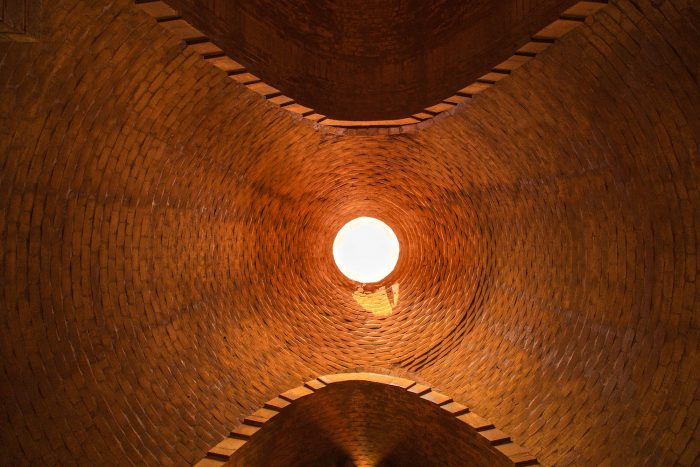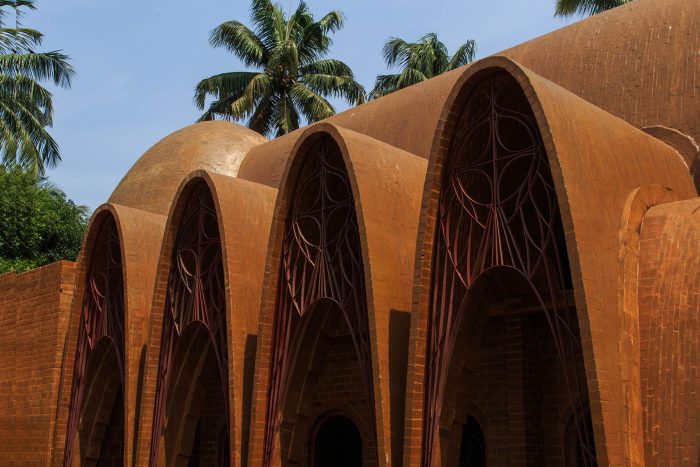这座教堂建在历史古迹的基础上,复活了原教堂,它是喀拉拉邦基督教徒的第一座教堂,建于公元1615年,经过多年的忽视和侵占,教堂已经残破不堪。教堂的设计使用稳定的土块形成努比亚拱门,教堂的分堂和过道由飞行托架支撑,没有百叶窗。作为一个小社区的宗教建筑,教堂需要建筑师和信任的客户进行大量的协商,才能实现这个梦想。. 探索精神与迫切的需求相结合,是设计诞生的地方;通过现场、泥瓦匠、建筑师和客户之间的一系列对话,设计得到进一步发展。
Built on the foundation of a historic monument, this church resurrects the original church which is the first church of the Christians in Kerala, built in 1615 AD and was left in shambles after years of neglect and encroachment. Designed using stabilized earth blocks to form Nubian arches, the alter and the aisles of the church are supported by flying buttresses that were built without shuttering. Being a religious building for a small community, the church would have demanded substantial negotiation from the architect and a trusting client to realize this dream. . The exploratory spirit combined with pressing demands is from where the design is born; which is further evolved through a series of dialogues between the site, the masons, the architect and the clients.
教堂的建筑建立在历史古迹的想象上,但材料在其潜在形式中的透明使用使这座建筑具有迷人的大厦。穹顶、拱顶和拱门笼罩着一个崇高的中央空间,光线从十字架(灵感来自安藤忠雄)中透出,框住了圣殿。泥瓦匠们接受了培训,使用一种连锁研究的方法来创造这些结构,这种方法最早是由安东尼-高迪(Antoni Gaudi)在哈桑-法蒂(Hassan Fathy)掌握的形式中制定的。尽管如此,教堂借用了所有的影响,结果是一个当代建筑的原创作品,利用独特的机会,为一个具有挑战性的方案建造。通过重新解释历史性的建筑技术,并对场地上的结构足迹做出回应,试图创造一个用土做的建筑,以其丰富的空间质量激发人们的敬畏和惊奇感。
The architecture of the church builds on the imagery of historic monuments but the transparent use of the material in its potential forms gives this building its fascinating edifice. The domes, vaults and arches envelop a sublime central space with light filtering through the cross (an inspiration from Tadao Ando) framing the sanctuary. The masons were trained to create these structures using a chain-study method first formulated by Antoni Gaudi in forms that were mastered by Hassan Fathy. Nonetheless, with all its influences the church borrows, the result is an original work of contemporary architecture that exploits the unique opportunity to build for a challenging programme. By re-interpreting a historic construction technique and responding to the footprint of the structure on the site, the attempt is to create a building made with earth that inspires awe and a sense Of wonderment with its rich spatial quality.
随着对资源的要求越来越高,建筑师有责任使用体现能量极少的材料。泥巴作为一种材料,可以通过土块、夯土、荆条、达布等多种方法来表现其真实的形态。探索精神与迫切的需求相结合,是我们的设计诞生的地方;这些设计是通过泥瓦匠、建筑师、客户之间的一系列对话以及对现场和周围环境的直接了解而发展起来的。
With increasing demand over resources, it is the responsibility of architects to use materials with very less embodied energy. Mud as a material can be expressed in its true form through various methods like earth blocks, rammed earth, wattle and daub and many more. The exploratory spirit combined with pressing demands is where our designs are born; which are evolved through a series of dialogues between the masons, architects, clients and an immediate understanding of the site and the surrounding.
施工技术。
1. CSEB。
– CSEB的能源消耗比乡下烧砖低4倍。
(现场生产的CSEB使用5%的水泥=1,112.36兆焦/立方米,而国家烧制的砖=4,501.25兆焦/立方米)
– CSEB的污染比乡下烧砖少4倍。
(现场用5%水泥生产的CSEB=110.11公斤二氧化碳/立方米,而国家烧制的砖头=444.12公斤二氧化碳/立方米)
CONSTRUCTION TECHNIQUES:
1. CSEB:
– CSEB consume 4 times less energy than country fired bricks:
( CSEB produced on site with 5 % cement = 1,112.36 MJ/m3 ,whereas that of Country fired bricks = 4,501.25 MJ/m3)
– CSEB pollutes 4 times less than country fired bricks:
( CSEB produced on site with 5 % cement = 110.11 Kg of CO2 /m3, whereas that of Country fired bricks = 444.12 Kg of CO2 /m3 )
2. 努比亚技术。
这是一种古老的建筑技术,用土块和泥浆砌筑,不加遮挡,可以建造各种拱门、圆顶和拱顶。该技术是由埃及建筑师哈桑-法西在20世纪重新引入的,这种技术的基础是砖块之间用土胶粘连。原理是,干燥的块吸毛细作用的水与粘土的胶水,这将绑定块。它是非常重要的块非常薄,以便有一个高比例的 “粘面积/重量”。(参考:http://www.earth-auroville.com/avd_construction_en.php )
2. NUBIAN TECHNIQUE:
An age-old construction technique involving masonry with earth blocks and mud mortar without shuttering to create a wide range of arches , domes and vaults. The was reintroduced to 20th century by the Egyptian architect Hassan Fathy.The basis of this technique is that the blocks adhere to each other with earth glue. The principle is that the dry block suck by capillarity the water along with the clay of the glue which will bind the blocks. It is essential that the blocks are very thin, so as to have a high ratio “sticking area/weight”. (Ref : http://www.earth-auroville.com/avd_construction_en.php )
3. 穩定化的方法。
链式研究法有助于在执行开始前稳定拱门的正确形状。20世纪初的西班牙建筑师安东尼奥-高迪开发并广泛使用了这种方法,其目的是确定自由悬挂的链条所承担的形状。”双链法 “给出了推力线的精确和理想曲线,它代表了拱门中的压应力线。
3. CATENARY METHOD FOR STABILIZATION :
Chain study method helps to stabilize the right shape of the arch before the execution begins. Antonio Gaudi, the Spanish architect of the early 20th century, developed and used extensively this method which aims to define the shape assumed by a freely suspended chain.The catenary method gives the exact and ideal curve of the line of thrust, which represents the line of compressive stress in the arch.
建筑师:Wallmakers
面积:221平方米
年份:2016年
摄影作品:Jino Sam
建筑师:Wallmakers, Vinu Daniel , Fawaz Thengilan, Ashand Raju, Melvin Davis, Shobitha Jacob, Archana M., Bibu Behanan, Jincy Rajan, Mohammed Rauf
城市:Kochi
国家:印度
Architects: Wallmakers
Area: 221 m²
Year: 2016
Photographs: Jino Sam
Architects:Wallmakers, Vinu Daniel , Fawaz Thengilan, Ashand Raju, Melvin Davis, Shobitha Jacob, Archana M., Bibu Behanan, Jincy Rajan, Mohammed Rauf
City:Kochi
Country:India
















